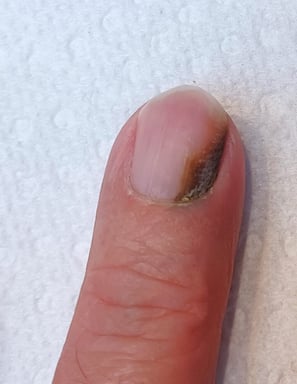Green Nail Syndrome: Causes, Symptoms, and Treatment
Green Nail Syndrome (GNS), caused by a resilient bacterium known as Pseudomonas aeruginosa, this condition leads to a distinctive greenish discoloration of the nails. While it’s not usually a serious health concern, it can be persistent and frustrating to deal with. Let’s dive deep into everything you need to know about Green Nail Syndrome—its causes, symptoms, treatment options, and preventive measures.
BACTERIALDERMATOLOGY
Rishwin A R
2/7/20252 min read


What Causes Green Nail Syndrome?
The primary culprit behind GNS is the Pseudomonas aeruginosa bacterium, which thrives in moist and warm environments. Here’s how it typically develops:
Frequent exposure to water – People who constantly have their hands submerged in water (e.g., dishwashers, swimmers, healthcare workers) are at a higher risk.
Nail trauma – Minor injuries, cracks, or habitual nail-biting can create an entry point for bacteria.
Tight-fitting or artificial nails – These can trap moisture, creating the perfect environment for bacterial growth.
Poor nail hygiene – Not keeping nails trimmed and clean can lead to bacterial accumulation.
Underlying medical conditions – Conditions like diabetes or immune deficiencies can make an individual more susceptible to infections.
Newly infected nail (Dark bluish-green discoloration of part of the nail, painless)
Symptoms of Green Nail Syndrome
Recognizing Green Nail Syndrome early can prevent further complications. The most common signs include:
Green or blue-green discoloration of the nail, caused by pigments produced by Pseudomonas aeruginosa.
Nail thickening and lifting from the nail bed, known as onycholysis.
Foul smell due to bacterial growth.
Pain or tenderness (though many cases are painless).
Brittle and weak nails, making them prone to further damage.
How Is Green Nail Syndrome Diagnosed?
Diagnosis is usually straightforward and based on clinical appearance. However, in some cases, a healthcare provider might:
Take a nail clipping or swab to confirm the presence of Pseudomonas aeruginosa.
Rule out fungal infections or other nail disorders.
Check for underlying health conditions that may be contributing to recurrent infections.
Treatment Options for Green Nail Syndrome
Thankfully, GNS is treatable with proper care. Here’s how you can manage it:
At-Home Remedies
If caught early, mild cases of Green Nail Syndrome can be treated at home with the following steps:
Trim and clean the affected nail – Keeping the area dry is key.
Vinegar or bleach soaks – Soaking the nail in a diluted vinegar (1:4) or bleach (1:10) solution for 5-10 minutes daily can help kill bacteria.
Avoid nail polish and artificial nails – These can trap moisture and worsen the infection.
Medical Treatments
For more severe or persistent cases, a doctor may recommend:
Topical antibiotics like ciprofloxacin or polymyxin B to kill the bacteria.
Oral antibiotics in stubborn cases where the infection doesn’t resolve with topical treatments.
Surgical removal in extreme cases where the nail is severely damaged or infected.
Preventing Green Nail Syndrome
Prevention is always better than cure! Here are some simple ways to avoid Green Nail Syndrome:
Keep nails short and clean to reduce bacterial buildup.
Dry hands thoroughly after washing to prevent moisture accumulation.
Wear gloves when doing water-intensive tasks like washing dishes.
Avoid prolonged exposure to hot tubs, pools, or other wet environments.
Be cautious with artificial nails – ensure they are properly applied and not trapping moisture.
FAQs About Green Nail Syndrome
1. Is Green Nail Syndrome contagious?
No, GNS is not contagious. It’s caused by bacteria that thrive in moist environments and does not spread from person to person.
2. Can Green Nail Syndrome go away on its own?
Mild cases may resolve with proper nail care, but persistent infections often require treatment.
3. How long does it take for Green Nail Syndrome to heal?
With proper care and treatment, most cases improve within a few weeks.
4. Can I still get a manicure if I have Green Nail Syndrome?
It’s best to avoid nail salons until the infection clears. Applying polish or artificial nails can trap bacteria and make the condition worse.
5. Can Green Nail Syndrome affect toenails?
Yes, while it’s more common in fingernails, toenails can also be affected, especially in individuals who frequently wear tight shoes or expose their feet to damp environments.
Syndromes.xyz
Explore medical syndromes and their details here.
For Educational purposes only
The information on this site is not in any way, replacement for professional advice. Always consult your physician regarding personal queries
Connect
Support
syndromesxyz@gmail.com
© 2024. All rights reserved.
